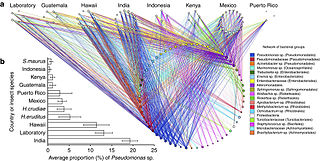Pseudomonas agarici is a Gram-negative soil bacterium that causes drippy gill in mushrooms. It was first isolated in New Zealand. P. agarici could not be grouped based on 16S rRNA analysis, so it is designated incertae sedis in the genus Pseudomonas.
Pseudomonas avellanae is a Gram-negative plant pathogenic bacterium. It is the causal agent of bacterial canker of hazelnut. Based on 16S rRNA analysis, P. avellanae has been placed in the P. syringae group. This species was once included as a pathovar of Pseudomonas syringae, but following DNA-DNA hybridization, it was instated as a separate species. Following ribotypical analysis Pseudomonas syringae pv. theae was incorporated into this species.
Pseudomonas corrugata is a Gram-negative, plant-pathogenic bacterium that causes pith necrosis in tomatoes. Based on 16S rRNA analysis, P. corrugata has been placed in the P. fluorescens group. For a more comprehensive phylogenetic analysis of P. corrugata and its closely related phytopathogenic bacterium P. mediterranea, refer to Trantas et al. 2015.
Pseudomonas ficuserectae is a nonfluorescent, Gram-negative, soil bacterium that causes bacterial leaf spot on a Japanese fig, from which it derives its name. Based on 16S rRNA analysis, P. ficuserectae has been placed in the P. syringae group.

Pseudomonas fulva is a Gram-negative environmental bacterium, originally isolated from rice and commonly associated with rice plants, grains and paddy fields. It is rod-shaped and motile using one to three polar flagella.
Pseudomonas mendocina is a Gram-negative environmental bacterium that can cause opportunistic infections, such as infective endocarditis and spondylodiscitis, although cases are very rare. It has potential use in bioremediation as it is able to degrade toluene. Based on 16S rRNA analysis, P. mendocina has been placed in the P. aeruginosa group.
Pseudomonas flavescens is a Gram-negative bacterium that causes blight cankers on walnut trees. Based on 16S rRNA analysis, P. flavescens has been placed in the P. aeruginosa group.
Pseudomonas libanensis is a Gram-negative, rod-shaped, fluorescent, motile bacterium isolated from natural springs in Lebanon. Based on 16S rRNA analysis, P. libanensis has been placed in the P. fluorescens group.
Pseudomonas veronii is a Gram-negative, rod-shaped, fluorescent, motile bacterium isolated from natural springs in France. It may be used for bioremediation of contaminated soils, as it has been shown to degrade a variety of simple aromatic organic compounds. Based on 16S rRNA analysis, P. veronii has been placed in the P. fluorescens group.
Pseudomonas mosselii is a Gram-negative, rod-shaped, bacterium clinically isolated in France. Based on 16S rRNA analysis, P. mosselii has been placed in the P. putida group.
Pseudomonas straminea is a Gram-negative, rod bacterium that includes strains formerly identified as P. ochracea. Based on 16S rRNA analysis, P. straminea has been placed in the P. aeruginosa group.
Pseudomonas aureofaciens is a yellowish, aerobic, Gram-negative, motile, polar-flagellated, rod-shaped bacterium isolated from clay near the River Maas. Based on 16S rRNA analysis, P. aureofaciens has been placed in the P. chlororaphis group.
Pseudomonas monteilii is a Gram-negative, rod-shaped, motile bacterium isolated from human bronchial aspirate. P. monteilii grows in temperatures below 40 degrees Celsius. The species is capable of respiratory metabolism, but not fermentative metabolism. Laboratory observations were made on the species' production of fluorescent pigments, cytochrome oxidases, and catalases. The species is named in honor of the French microbiologist Henri Monteil.
Pseudomonas balearica is a Gram-negative, rod-shaped, nonfluorescent, motile, and denitrifying bacterium. It is an environmental bacterium that has been mostly isolated from polluted environments all over the world. Many of the isolates have demonstrated capabilities to degrade several compounds. Some of the strains are naphthalene degraders and one strain isolated in New Zealand has demonstrated the potential to oxidize inorganic sulfur compounds to tetrathionate. Based on 16S rRNA analysis, P. balearica has been placed in the P. stutzeri group.
Pseudomonas plecoglossicida is a fluorescent, Gram-negative, rod-shaped, motile bacterium that causes hemorrhagic ascites in the ayu fish, from which it derives its name. Based on 16S rRNA analysis, P. plecoglossicida has been placed in the P. putida group.
Pseudomonas cedrina is a Gram-negative, rod-shaped bacterium isolated from spring waters in Lebanon. Based on 16S rRNA analysis, P. cedrina has been placed in the P. fluorescens group.
Pseudomonas orientalis is a Gram-negative, rod-shaped bacterium isolated from spring waters in Lebanon. Based on 16S rRNA analysis, P. orientalis has been placed in the P. fluorescens group.
Pseudomonas migulae is a fluorescent, Gram-negative, rod-shaped bacterium isolated from natural mineral waters in France. This bacterium has also been isolated from endophytic tissues of lodgepole pine trees growing on gravel mining sites with potential to perform biological nitrogen fixation and plant growth promotion. Based on 16S rRNA analysis, P. migulae has been placed in the P. fluorescens group.
Pseudomonas rhodesiae is a Gram-negative, rod-shaped bacterium isolated from natural mineral waters. Based on 16S rRNA analysis, P. rhodesiae has been placed in the P. fluorescens group.
Pseudomonas nitroreducens is an aerobic, Gram-negative soil bacterium first isolated from oil brine in Japan. It is able to synthesise polyhydroxybutyrate homopolymer from medium chain length fatty acids. Based on 16S rRNA analysis, P. nitroreducens has been placed in the P. aeruginosa group.
